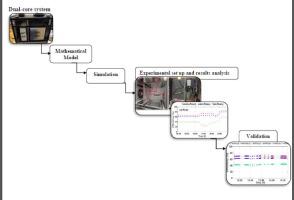Energy and Buildings ( IF 6.7 ) Pub Date : 2020-11-03 , DOI: 10.1016/j.enbuild.2020.110600 Haïfa Souifi , Yassine Bouslimani , Mohsen Ghribi , Serge Colin

|
With the present leaning towards well-insulated and airtight energy-efficient buildings and houses, air-to-air heat/energy exchangers have become very important for maintaining a good indoor air quality (IAQ) via continuous mechanical ventilation along with decreasing energy needed to condition the inbound fresh air. The present study aims to experimentally evaluate the performances of a dual-core ERV-HRV system in terms of heat and energy recovery in residential environment under Atlantic Canada weather. An IoT platform was designed and integrated to this ventilation system in order to collect and log real-time data. Moreover, this paper presents a detailed mathematical model of the proposed system to predict its energy exchange efficiency, using the effectiveness-NTU (i.e. ) approach. The model was subsequently validated against experimental measurements within laboratory environment. As proved by experimental data, the theoretical model can predict, with a relative discrepancy less than 10%, the system energy exchange efficiency. Results from a real house located at Sainte-Anne-de-Kent in New-Brunswick, Canada are presented in this study, and the system efficiency was assessed under hot and cold weather conditions. The research findings show that, in the winter, the measured sensible and latent efficiencies are in ranges of 65.66–85.05 % and 38.46–58.96 %, respectively. Whereas, for the summer season, the corresponding effectiveness ranged from 31.7 % to 85.72 %, and from 68.51 % to 92.69 %, respectively. As consequence, the experimental results analysis revealed that the proposed dual-core exchanger is efficient during both heating and cooling seasons.
中文翻译:

双芯空对空换热器的实验研究与建模
由于目前倾向于隔热良好且气密的节能建筑和房屋,空对空热/能源交换器对于通过持续的机械通风以及减少所需的能源来保持良好的室内空气质量(IAQ)变得非常重要。调节入站新鲜空气。本研究旨在通过实验评估加拿大大西洋地区居民环境中住宅环境中的热能回收利用方面的双核ERV-HRV系统的性能。设计了一个物联网平台并将其集成到该通风系统中,以收集和记录实时数据。此外,本文提供了一个详细的数学模型,该系统使用有效性-NTU来预测其能量交换效率(即)方法。随后针对实验室环境中的实验测量对模型进行了验证。实验数据证明,该理论模型可以预测系统能量交换效率,相对差异小于10%。这项研究显示了位于加拿大新不伦瑞克省Sainte-Anne-de-Kent的一所真实房屋的结果,并在炎热和寒冷的天气条件下评估了系统效率。研究结果表明,在冬季,测得的感性和潜性效率分别在65.66–85.05%和38.46–58.96%的范围内。而对于夏季,相应的有效性分别为31.7%至85.72%和68.51%至92.69%。结果,



























 京公网安备 11010802027423号
京公网安备 11010802027423号